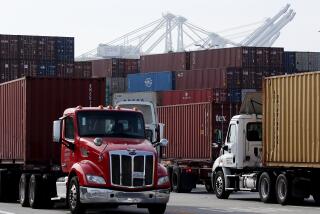Computerized Weight-Monitoring System Will Speed Up Trucking
Truckers will zoom through the county with less hassle after a new weight-monitoring system being installed on the Ventura Freeway gets up and running this week.
Large metal poles were extended over the freeway on both sides of the Conejo Grade last week. Now maintenance crews are attaching the wires and connecting transmitters that will help create smoother truck flow by eliminating the need for scores of 18-wheelers to stop to be weighed, said California Highway Patrol officials.
For the record:
12:00 a.m. Sept. 1, 2000 For the Record
Los Angeles Times Friday September 1, 2000 Ventura County Edition Metro Part B Page 3 Zones Desk 2 inches; 43 words Type of Material: Correction
Weigh station--A story Wednesday contained inaccurate information about PrePass, a device that will electronically exempt some truckers from stopping at a weigh station on the Conejo Grade. Truckers using PrePass will not be required to occasionally stop for a visual inspection after being cleared.
Here’s how the system works:
If a truck is signed up for the PrePass system, it is automatically weighed when passing over sensors embedded in the road. The weight registers with a computer, which sends a signal to a transponder mounted in the truck’s window.
If the vehicle is within legal weight, a green light flashes on the truck’s windshield and the driver may pass without stopping. If the load is too heavy, a red light flashes and the trucker must stop to have his truck weighed at the Conejo Inspection Facility, like all trucks without PrePass.
Every time a big rig uses PrePass, its trucking company is charged 99 cents.
“It’s like a toll road,” said Beth Rider, who manages the customer service center for PrePass. “If you use a road, you pay. It’s the same thing.”
A truck with the PrePass system can avoid the fee by stopping at the weighing facility for free inspection like other trucks.
The system has operated elsewhere in California since 1995 and, according to Rider, is a great success. There are 99 such electronic weighing systems on heavily traveled truck routes. More than 5,800 trucking companies nationwide have PrePass accounts, she said.
The Conejo Grade project, at a cost of $487,000, is overseen by a partnership between the trucking industry and state transportation departments, which selected Lockheed Martin Corp. to do the installations. Every year, states submit a list of preferred sites for the system. There is no cost to taxpayers.
Truckers who comply with all the weight and interstate commerce requirements sail through these inspection points without needing to pull into a facility, where the average time spent is about 10 minutes but can sometimes be hours.
Drivers love it because it shortens their trips and they are spared the inconvenience of dealing with station after station reviewing the same load.
When stopping for inspection, trucks are checked not only for weight but also for mechanical problems with brakes, suspension and frame before being allowed to move on, said operators. The weight limit, 80,000 pounds, is intended to ensure that trucks don’t cause too much road damage and to prevent weight-related brake failure.
Gary Peldo, a trucker from Illinois, was hauling forklifts to Santa Maria earlier this week and stopped at the Conejo Grade facility. His truck is fitted with the PrePass monitor; he said he would be grateful when the system is activated in Ventura County.
“I think every station should have them,” he said. “I just love them. It saves me time and hassle.”
Truckers are required to stop after using PrePass 15 times, so inspectors can physically review the vehicle for mechanical problems.
*
For their part, truck scale inspectors, who in California work for the Highway Patrol, will have less work on their hands when some vehicles drive straight through to the next stop. And the hazards caused by trucks queuing up in the slow lane will be virtually eliminated.
CHP Sgt. Kent Kilgore, shift supervisor at the Conejo Grade facility, said 10% of the 65,000 or so trucks that go through the weigh station each month may not have to stop.
“Lucky’s [supermarket] may have someone come through six times a day. If he only comes in every 15th trip, he will save quite a bit of his time and our time every day,” he said.
More to Read
Sign up for Essential California
The most important California stories and recommendations in your inbox every morning.
You may occasionally receive promotional content from the Los Angeles Times.










